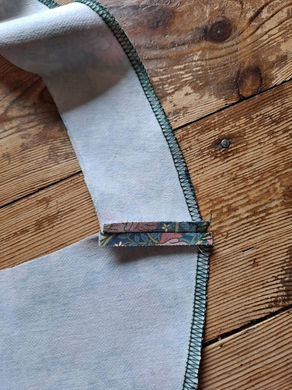Facings
Here's a few different ways you can finish the exposed edge of facings. The choice is yours, I use all of them depending on the type of fabric and where in the garment the facing will be.
Many people ask why do patterns have facings when my bought clothes don't?
The quick answer is cost! Facings take more fabric and they need interfacing. Plus there's added labour costs as the interfacing needs fusing to the fabric, often before cutting the pieces. The process also causes more waste. All these things add to the overall production cost.
Facings add structure to a garment which helps the garment to hang better.

Overlock or Zig zag
This is the quickest and easiest way to neaten the inside edge of a facing. You can overlock right on the edge or use a zig zag or overcast stitch on your machine. My sample uses a 3 thread overlock, it uses less thread and it's a personal choice if you remove the left or right needle from your overlocker. Often I still use 4 threads as it's much quicker.
Zig zag stitch is the easiest method with your sewing machine. The best foot to use is your overcast foot with stitch width 4, length 2. If you don't have an overcast foot sew just inside the edge of the fabric and then trim off any extra fabric.
Your machine might have an overcast stitch which is brilliant with the overcast foot, but does use more thread.
Straight Stitch
This method works really well on lighter fabrics, including cotton poplin and lawn. Interfacing is usually fused first, however I've included pictures using silk organza as an interfacing with lightweight silk fabric.
Although this first step isn't essential with fused interfacing it really can make make it easier to turn over the edge of the facing. If you're using sew-in interfacing then yes, it's really important.
Sew a line of straight stitch 1/4"(6mm) from the outer edge of the facing. Use your 1/4" foot if you have one, but most machines have a foot similar to the one in my picture. Line the edge of the fabric up with the join where the plastic meets the metal.
If there's a corner on your facing like I had recently, turn the corner to the wrong side with the stitching on the fold.
Press the edge of the facing to the wrong side using the stitching as a guide. Press.
Straight stitch close to the folded edge.
If you've used sew-in interfacing - after doing the first row of straight stitching trim the interfacing right next to the stitching, it makes turning the edge of much easier.

Bound Edge
For heavier fabrics used for unlined jackets or on a waistband facing you can bind the edge, sometimes called a Hong Kong finish.
I'll add pictures next time I do this!
I like to use a very lightweight fabric to avoid bulk.
Cut bias strips about 3cm wide.
Place right sides together on the edge of the facing. Sew 1/4" seam.
Press the binding towards the edge of the facing.
Fold the binding round the edge of the facing making a crisp edge. Press
Stitch in the ditch. Sew really close to the inner edge of the binding catching in the underneath layer.
I don't fold in the under edge of the binding as it adds unnecessary bulk and the bias cut fabric isn't going to fray.
Invisible Edge
This is lovely for edges that might be seen like an unlined jacket or just for beautiful lightweight fabrics.
Put the interfacing right side against the right side of the facing .
Sew a 1/4" seam
Carefully iron the interfacing to the seam allowance. Use the edge or tip of the iron.
Turn the interfacing so it's wrong side against the wrong side of the facing. Try to fold so the main fabric rolls slightly to the wrong side.
Press.
If the interfacing is slightly wider than the facing you can trim off the extra.










